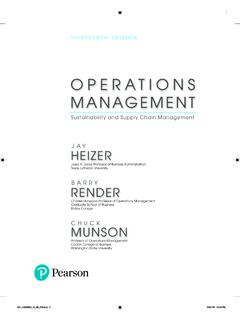Transcription of Introduction to Leadership: Concepts and ... - tamut.edu
1 1 Introduction to leadership : Concepts and Practices leadership leadership and learning are indispensable to each other. ~John F. Kennedy Effective Date: Spring, 2016 Instructor: Lila B. Walker, Office: Adjunct not on campus Phone: (903) 824 1986 E mail: Office Hours: As I am not on campus, please contact me at the e mail or phone number listed. I. Course Number: 305 II. Course Title: Introduction to leadership : Concepts and Practices III. Semester Credit Hours: 3 IV. Course Description: This course is designed to provide a basic Introduction to leadership by focusing on what it means to be a good leader.
2 Emphasis in the course is on the practice of leadership . The course will examine topics such as: understanding leadership ; recognizing leadership traits; engaging people s strengths; understanding philosophy and styles; attending to tasks and relationships; developing leadership skills; creating a vision; establishing a constructive climate; listening to out group members; handling conflict; addressing ethics in leadership and overcoming obstacles. Students will assess their leadership traits and skills to improve their own leadership performance.
3 V. Course Delivery Method: Web based VI. Required Textbooks/Resources: Northouse, P. G. (2014). Introduction to leadership : Concepts and Practice (3rd ed.). SAGE ISBN: 978 1 4522 5966 6 Required: Yes VII. Student Learning Outcomes: 1. Students will assess potential leadership philosophy, traits, skills, behaviors, and develop a leadership portfolio. 2. Students will exercise an understanding of the fundamental ways leadership is practiced in on going organizations. 3. Students will evaluate fundamental leadership practices relevant to contemporary organizations.
4 4. Students will enhance their writing skills by comparing and contrasting different leadership approaches. 2 VIII. Course Outline: Week #1 Chapter 1 Understanding leadership (Northouse) Lecture, Readings, & Videos: Defining leadership ; Global leadership Attributes; Practicing leadership . leadership Portfolio : Conceptualizing Questionnaire; Observational Exercise; Reflection and Action Worksheet This worksheets are to be complete by the student weekly, but will not be submitted each week. Week #2 Chapter 2 Recognizing Your Traits (Northouse) Lecture, Readings, & Videos: Historical Leaders; What Traits Do These Leaders Display?
5 leadership Studies: What Traits Do Effective Leaders Exhibit? case Study #1: An Emerging Leader Discussion Question #1 leadership Portfolio: leadership Traits Questionnaire; Observational Exercise; Reflection and Action Worksheet Chapter 3 Engaging People s Strength (Northouse) Lecture, Readings, & Videos: Explore how strengths can make one a better leader. Understand the concept of strength; Describe the historical background of strengths based leadership . Examine how to identify strengths; Review measures used to assess strengths; Examine strengths based leadership in practice.
6 leadership Portfolio: leadership Styles Questionnaire; Observation Exercise; Reflection and Action Worksheet. Week #3 Chapter 4 Understanding Philosophy and Styles (Northouse) Lecture, Readings, & Videos: leadership Explained Theory X and Theory Y; leadership Styles Explained; leadership Styles in Practice leadership Portfolio: Task and Relationship Questionnaire; Observational Exercise; Reflection and Action Worksheet Chapter 5 Attending to Tasks and Relationships (Northouse) Lecture, Readings, & Videos: Task and Relationship Styles Explained; Task and Relationship Styles in Practice leadership Portfolio: leadership Skills Questionnaire.
7 Observational Exercise; Reflection and Action Worksheet Discussion Question #2 case Study#2: Many Managers, Different Styles Week #4 Chapter 6 Developing leadership Skills (Northouse) Lecture, Readings, & Videos: Understanding administrative skills and their use in practice. Understanding interpersonal skills and their use in practice. Understanding conceptual skills and their use in practice. leadership Portfolio: leadership Vision Questionnaire; Observational Exercise; Reflection and Action Worksheet Mid term Exam 3 Week #5 Chapter 7 Creating a Vision (Northouse) Lecture, Readings, & Videos: Understand the characteristics of a vision.
8 Examine the process of vision articulation; Discuss vision implementation; Focus on how to develop a workable vision for different contexts. leadership Portfolio: Setting the Tone Questionnaire; Observational Exercise; Reflection and Action Worksheet Chapter 8 Establishing a Constructive Climate (Northouse) Lecture, Readings, & Videos: Understand the concept of constructive climate; Review factors considered to establish constructive climate; Explain the process for providing constructive feedback to employees. leadership Portfolio: Responding to Members of the Out Group Questionnaire; Observational Exercise; Reflection and Action Worksheet Week #6 Chapter 9 Listening to Out Group Members (Northouse) Lecture, Readings, & Videos: Conflict Defined; Kinds of Conflict; Fisher and Ury Approach to Conflict; Strategies for Conflict Resolutions; and Killman and Thomas Styles of Approaching Conflict leadership Portfolio: Conflict Style Questionnaire; Observational Exercise.
9 Reflection and Action Worksheet Chapter 10 Handling Conflict (Northouse) Lecture, Readings, & Videos: Conflict Explained Communication and Conflict and Conflict on the Content Level; Handling Conflict in Practice case Study#3: Office Space leadership Portfolio: Path Goal Theory Questionnaire; Observational Questionnaire; Reflection and Action Worksheet ethical Dilemma Paper case Study #3: Office Space Week #7 Chapter 11 Addressing Ethics in leadership (Northouse) Lecture, Readings, & Videos: ethical leadership is about the following: the Character of the Leader, Action of the Leader, Goals of Leader, Honesty of the Leader, Power of the Leader, Value of Leader case Study#4: The Write Choice leadership Portfolio: Core Value Questionnaires; Observational Exercise.
10 Reflection and Action Worksheet Chapter 12 Overcoming Obstacles (Northouse) Lecture, Readings, & Videos: Discuss the concept of obstacles in the workplace. Discuss obstacles in practice. Highlight seven major obstacles derived from path goal theory of motivation. Describe each obstacle and the various ways leaders can respond to these obstacles. 1 Unclear Goals; Obstacle#2 Unclear Direction; Obstacle#3 Low Motivation; Obstacle#4 Complex Tasks; Obstacle#5 Simple Task; Obstacle#6 Low Involvement; Obstacle#7 Lack of Challenge Discussion #4 ethical Dilemma Paper Week #8 Final Exam leadership Profile Portfolio 4 Methods of Evaluation Course Evaluation: Points *Syllabus Pop Quiz 10 points Student Introductions (Discussion Board) 10 points Discussion Board case Studies (Four @ 20 points each) 80 points Mid Term Exam 100 points Final Exam 100 points leadership Profile Portfolio 50 points Presidential Candidate Paper 50 points Total Points: 400 A: 400 360 B.








